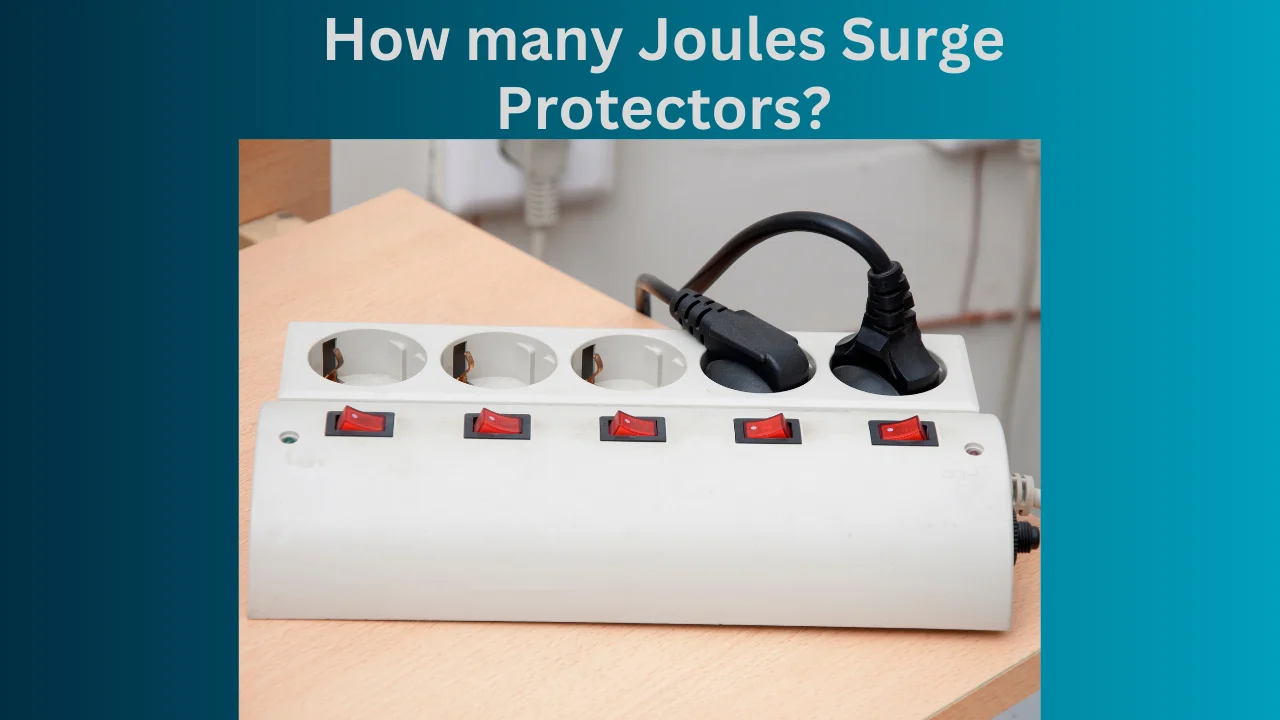Learn the importance of joule rating in safeguarding electronic devices before deciding on a surge protector’s joule rating. A surge protector’s capacity to absorb energy is reflected in its joule rating, which is a measure of how well it shields devices from voltage spikes. To better withstand power surges, a surge protector should have a high joule rating. A surge protector rated between 200 and 400 joules should be more than enough for simple electrical appliances like lamps and alarm clocks. However, a surge protector with a joule rating of 1000 joules or higher is advised for more delicate and expensive devices such as computers, home theater systems, or gaming consoles. Surge protectors with 2000 joules or higher ratings are recommended for high-end electronics or home office setups that require maximum protection. Important considerations include the significance of the protected devices and the frequency of power surges in your region. How many joules surge protectors? should have depends on the specific needs and value of the equipment, ensuring effective protection against potential electrical damage.
Getting a Grip on Surge Protectors
Definition and Purpose
Devices made to shield electrical devices from spikes and surges are called surge protectors or surge suppressors. Many things can cause power surges, including lightning, power outages, or the abrupt activation or deactivation of powerful electronics. A surge protector’s job is to prevent damage to connected devices by directing the excess voltage to the ground.
Components and Functionality
Important parts of surge protectors include gas discharge arrestors, transient voltage suppression diodes, and metal oxide varistors (MOVs). These parts coordinate to identify overvoltage and redirect it away from the safeguarded electronics. The MOVs play a crucial role because they take in the extra energy and release it as heat.
Importance of Joule Rating
A surge protector’s ability to absorb energy is indicated by its joule rating. It is a measure of the surge protector’s maximum allowable power before it trips. Since a higher joule rating indicates that the device can absorb more energy, it provides better protection against power surges. In order to choose the best surge protector, it is essential to be familiar with joule ratings.
Types of Surge Protectors
Power strip, wall-mounted, and whole-house surge protectors are just a few of the varieties of surge protectors on the market. There is a wide range of protection levels and purposes provided by each type. Which one is best depends on the devices you’re trying to safeguard and the conditions under which they operate.
Chosen the Appropriate Joule Value
Basic Electronic Devices
A surge protector with a joule rating of 200 to 400 joules is usually enough for basic electronic devices like lamps, alarm clocks, or kitchen appliances. A lower joule rating will still offer sufficient safety against minor power surges, as these devices do not require high levels of protection.
Computers and Office Equipment
Power surges can cause more damage to computers and other office equipment, such as printers and routers. A surge protector with at least 1000 joules is suggested for these devices. Protecting your data and equipment to this extent will keep them safe from power surges that you might not expect.
Home Entertainment Systems
Televisions, audio systems, and gaming consoles—all components of home entertainment systems—are likewise susceptible to power surges. For these devices, it is recommended to use a surge protector with a 1500 joules rating or higher. Your pricey electronics will be better protected from harm and continue to work properly thanks to this higher rating.
High-End Electronics
Professional audio equipment, state-of-the-art gaming setups, and home theater systems all require surge protectors with 2000 joules or higher ratings. To avoid costly repairs caused by power surges, these devices require strong protection.
Considerations for Choosing a Joule Rating
Frequency of Power Surges
Before you buy a surge protector, you should find out how often power surges happen where you live. Surge protectors with higher joule ratings may be necessary to guarantee continuous protection in areas that experience frequent power outages or lightning storms.
Value of Protected Devices
The devices’ monetary worth is another important factor to consider. To guarantee complete protection, surge protectors with higher joule ratings are recommended for more expensive and sensitive equipment. Think about how much it could cost to replace broken devices vs how much the surge protector would cost.
Type of Environment
Another important factor to consider is the environment where the surge protector will be used. Large power surges, for example, might be more common in commercial buildings with lots of heavy machinery than in homes. A surge protector with a higher joule rating is required in these instances.
Warranty and Insurance
There is often a warranty or connected equipment insurance that comes with surge protectors. A minimum joule rating for various equipment types is often specified in these warranties. If you want to be safe from power surges, get a surge protector that goes above and beyond what is recommended.
Special Considerations for Specific Devices
Surge Protectors for Computers
Think about the joule rating and other features, like data line protection and USB charging ports, when you’re picking out a surge protector for computers. To safeguard delicate computer parts from sudden voltage increases, a joule rating of 1000 is advised.
Home Theater Systems
An ideal surge protector for home theater systems would have 1500 joules of capacity. Additional safety and convenience features include configurations with multiple outlets and protection for coaxial cables.
Gaming Consoles
You need a surge protector with a joule rating of at least 1000 to 1500 joules for your gaming console. Due to their sensitivity to power surges, consoles are frequently left on for long periods of time. Continuous protection is guaranteed by a higher joule rating.
Kitchen Appliances
A surge protector rated between 400 and 600 joules is usually enough for kitchen appliances like refrigerators, coffee makers, and microwaves. Surge protection is useful for these devices even though they don’t need it as much as high-end electronics.
Maximizing Surge Protector Efficiency
Proper Installation
The effectiveness of surge protectors can be greatly enhanced with careful installation. Make sure all of the devices are plugged in correctly and that the surge protector is connected directly to the power source. If you want to keep your surge protectors working at their best, don’t daisy-chain them.
Regular Maintenance
Checking for frayed cords or loose connections is an important part of routinely maintaining surge protectors. After their useful life has expired or if they show indications of damage, surge protectors should be replaced.
Monitoring and Replacement
Protectors against surges are not permanent. Their capacity to soak up energy decreases with time. Keep an eye on your surge protectors and replace them every two to three years, or after a major power surge, whichever comes first.
Using Surge Protectors with UPS
Extra security for mission-critical equipment can be achieved by combining surge protectors with UPS systems. Devices can continue to function even when the power goes out thanks to UPS systems, which provide both surge protection and battery backup power.
FAQs
What is the best joule rating for a surge protector?
The best joule rating for a surge protector depends on the devices you need to protect. For basic electronics, 200 to 400 joules may suffice, while more sensitive equipment like computers and home theater systems require 1000 to 2000 joules or more.
Is a higher joule rating better for a surge protector?
Yes, a higher joule rating indicates that the surge protector can absorb more energy, providing better protection for your devices. However, the appropriate joule rating depends on the specific needs and value of the equipment being protected.
How to choose the right joule rating for a surge protector?
To choose the right joule rating, consider the type and value of the devices you are protecting, the frequency of power surges in your area, and any additional features required, such as data line protection or coaxial cable protection.
What happens if a surge protector’s joule rating is too low?
If a surge protector’s joule rating is too low, it may not provide adequate protection during a significant power surge, potentially leading to damage or destruction of connected devices. It is crucial to select a surge protector with an appropriate joule rating for your needs.
How many joules for a surge protector for a TV?
For a TV, a surge protector with at least 1000 joules is recommended. This provides sufficient protection against common power surges and helps ensure the longevity of your television.
Conclusion
In order to protect your electronic devices from power surges, it is essential to know what the recommended joule rating of a surge protector is. The devices’ types, values, and the frequency of power surges in your area are some of the factors that determine the appropriate joule rating. How many Joules Surge Protectors? You can prolong the life of your expensive electronics and prevent damage to them by picking a surge protector with the right joule rating. Before making a final choice, think about your devices’ individual requirements as well as the conditions in which they will be used.

Shannon Reyes is a seasoned writer with a knack for crafting engaging blogs on a variety of service industries, including plumbing, cleansing, moving, pest control, and roofing. With a keen eye for detail and a passion for helping readers navigate complex topics, Shannon brings her expertise to life through informative and accessible content.











